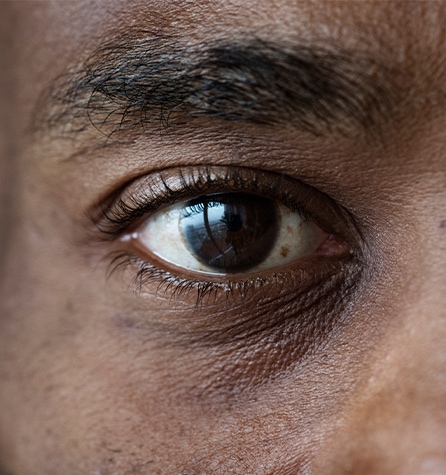Preventing Eye Problems
Eyes are complex systems involving delicate tissue and intricate neural pathways. From the front of the eye to the back of the brain, there are a lot of cells, nerves, and tissue to care for to preserve healthy vision. Regular eye exams assess every part of your vision—from front to back—to help detect changes, conditions, and diseases.
Optometrists can help diagnose and manage various eye problems. Protect your eye and vision health by visiting Advanced Eye Center for an exam.



It’s More Than Vision Care
Vision care is more than eye care. We look at the microscopic details and the big picture, so we can support your whole-body health. Your eyes can show us a lot about you, and we love getting to know our patients. We want to support your sight and health, and regular eye exams are just part of what we do.
Evaluating your eye health and vision can help diagnose conditions affecting your lifelong health, including autoimmune disorders, diabetes, high cholesterol, hypertension, and vascular diseases.

Common Eye Conditions & Diseases
Optometrists are knowledgeable about many eye diseases and conditions. They can help manage and treat eye problems or direct you to an appropriate health provider when necessary. See some common eye problems our optometrists can help diagnose and manage.
Cataracts
A cataract is a cloudy or opaque spot on the eye’s clear lens. The flexible lens changes shape to help focus light inside the eye, stretching or shrinking for seeing different distances. When proteins in the lens break down, they clump together—forming a cataract—and reducing the lens’ flexibility.
People with cataracts experience gradually decreasing vision at all distances. Cataracts are a leading cause of low vision and blindness in the US.
Many people develop cataracts over age 55, as the lens can become more rigid, resulting from natural aging. However, lifestyle factors and health conditions can contribute to development, including smoking, excessive alcohol consumption, and UV exposure.
Cataracts cannot be reversed or cured, but there are management options to sharpen vision, like glasses or contact lenses. In the later stages of development, cataract surgery may be recommended to restore sight.
Conjunctivitis (Pink Eye)
Although pink eye is best known for making rounds in schools, it can affect all ages—and have long-term symptoms when untreated.
Pink eye or conjunctivitis is the inflammation of the conjunctiva, a clear covering of the eye’s surface and inner eyelids. The thin layer shields the eye from infection and debris. When the tissue is irritated, tiny blood vessels expand, making the eye appear red or pink.
Conjunctivitis can be caused by allergies, bacteria, viruses, or chemical exposure. Allergic and chemical conjunctivitis are not contagious and result from a foreign substance contacting the eye. However, bacterial and viral conjunctivitis are highly infectious.
Treatment can help reduce inflammation to prevent symptoms from worsening. Your optometrist can also prescribe medication, such as antihistamine eye drops for allergic conjunctivitis or antibacterial ointment for bacterial conjunctivitis.
Dry Eye
Dry eye or dry eye syndrome is a common eye problem related to tear production. A layer of tears–called the tear film–coats the eye’s surface, providing moisture and nourishment. The term film has 3 components: the watery layer, the oily layer, and the mucus layer.
People can experience dry eye symptoms when their eyes cannot produce the components necessary to supply the tear film. For example, when the meibomian glands cannot make the oily layer of tears, the tear film evaporates too quickly to wet the eye.
Dry eye increases the risk of infection, as the tears cannot adequately clean and nourish the eye. As a result, chronic dryness and repeat infection can lead to corneal scarring, impairing vision.
Common dry eye symptoms include:
- Blurry vision
- Excessive eye watering
- Feeling something stuck in the eye
- Light sensitivity
- Scratchy, burning eyes
Our optometrists can help you manage your symptoms, from at-home eye care to in-office treatments. At Advanced Eye Center, some treatments we offer include:
- Eye drops—various types of artificial tears can add moisture to support the eye’s natural tear film, whether your at-home or on-the-go.
- Lid & gland debridement—cleaning excess bacteria, cells, and debris from the eyelids helps unblock tear glands, reduce inflammation, and improve tear flow.
- LipiFlow—the thermal pulsation system uses warmth and gentle massage to melt blocked oil in the tear glands to restore tear quality.
- Lumenis OptiLight —an noninvasive intense pulsed light (IPL) treatment focused on the area around the eyes to help unclog the tear glands, reduce inflammation, and stimulate tear flow.
- Meibomian gland expression—massaging the eyelids to unblock the tear glands, gently pushing out oils trapped in the meibomian glands.
Flashes of Light
You can see stars, flashes, or lightning bursts when tissue inside the eye suddenly pulls or stimulates the retina. Flashes of light can be harmless. For example, when the vitreous humor (gel-like fluid inside the eye) shrinks or changes with age, it can pull on the retina. You may also see light flashes when you rub your eyes too hard.
When you see repeated flashes of light, it can indicate a severe eye problem, like retinal detachment. A sudden flash after an eye or head injury can also be a symptom of a significant health condition.
Having your eye health evaluated after an injury or an increase in flashes can help rule out a severe problem—or ensure you receive treatment as soon as possible.
Floaters
Floaters are so-called because they seem to float across your sight. The floating, semi-transparent objects can be various shapes and sizes, often appearing like spots or strings. Yet, the objects are not floating over your sight but inside your eye.
The vitreous humor is the clear, gel-like substance located behind the lens and the retina (back of the eye). The vitreous gives your eye shape and helps cushion delicate eye tissue. The gel-like fluid can change or deteriorate because of aging or disease, forming clumps of cells.
The clumps are trapped in the vitreous, casting shadows when light passes through the eye—causing the appearance of floaters. Most floaters are harmless and typically do not impact vision. However, floaters can be a symptom of other eye problems, including:
- Eye infections or injuries
- Diabetes
- Retinal detachment
- Vitreous detachment
Glaucoma
Glaucoma is an eye disease that causes optic nerve damage. The optic nerve sends visual information from the retina to the brain. When the nerve fibers deteriorate, it can significantly reduce vision, beginning with peripheral (side) vision loss and eventually causing blindness.
There are multiple forms of glaucoma, but the most common is open-angle glaucoma. It’s caused by increased eye pressure when fluid accumulates inside the eye. In a healthy eye, fluid drains and is replenished in equal amounts. However, when drainage is blocked, or blood vessel damage increases fluids, the building pressure can damage the optic nerve.
Optometrists use tonometry to test eye pressure and visual field testing to evaluate peripheral vision. Then, when glaucoma is diagnosed, we can recommend an appropriate treatment method to preserve your sight.
Retinal Detachment
The retina is a thin tissue layer at the back of the eye. It detects and uses light to create visual information. Unfortunately, the retina is delicate and can dislodge from the back of the eye because of injury or disease.
When the retina tears or detaches, it can cause flashes of light, increased floaters, and vision loss. Patients may see a dark shadow or curtain falling across their vision.
Retinal detachment can lead to vision loss, so seeking treatment as soon as possible is crucial for saving sight. Re-attachment treatment is successful for 90% of people.

Early Detection Can Save Sight
Our focus at Advanced Eye Center is improving lives through vision care. Early detection and management can help save sight, so you experience the best possible vision every day. Visit Advanced Eye Center for regular eye exams and personalized advice about protecting your eye health.

Our Featured Services







